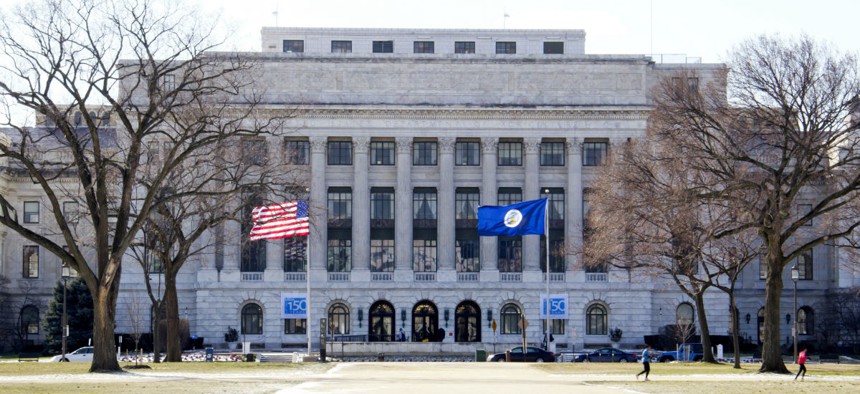
By MoDoGN / Shutterstock.com
Critics of Agriculture’s Planned Office Moves Seek Funding Halt
Statistical association and others write to appropriators challenging rationale behind the relocation plans.
As the Agriculture Department proceeds with site selection for a controversial move of two research offices outside of Washington, dozens of science and advocacy groups have stepped up their opposition.
On Nov. 13, a coalition of some 60 science, research and advocacy groups sent House appropriators a letter requesting that no funding for the moves—which would affect about 700 employees at the Economic Research Service and National Institute of Food and Agriculture—be provided in fiscal 2019. They also asked for a delay in the process “in order for Congress and stakeholders to understand the problems USDA seeks to address and the ramifications of the USDA’s proposed moves.”
Signatories ranged from the American Dairy Science Association to the American Educational Research Association to the Xerces Society for Invertebrate Conservation.
“Our fundamental concern is that the proposed relocation and realignment will undermine the quality and breadth of the work these agencies support and perform–work that is vital to informing and supporting U.S. agriculture, food and rural economies,” said the letter to Rep. Robert Aderholt, R-Ala., chairman of the House Appropriations Subcommittee on Agriculture, Rural Development, Food and Drug Administration, and Related Agencies, and its ranking member, Rep. Sanford Bishop, D-Ga. Also copied were Sen. John Hoeven, R-N.D., chairman of the Senate Appropriations Subcommittee on Agriculture, Rural Development, Food and Drug Administration, and Related Agencies, and ranking member Sen. Jeff Merkley, D-Ore.
Agriculture Secretary Sonny Perdue has argued that the moves will help with recruitment by locating the offices closer to land-grant universities in areas where the cost of living is lower than that of the Washington region. And an organizational restructuring that would return the Economic Research Service to the office of the chief economist will “enhance the effectiveness of economic analysis at USDA,” the agency has said.
“The rationale provided by the USDA for the relocation also fails to identify problems substantive enough to justify such a disruption of ERS’s and NIFA’s operations,” the critics argued in their letter. “USDA’s decision to move forward with the relocation and realignment without stakeholder and congressional input and without a cost-benefit analysis raises serious concern.”
Meanwhile, the American Statistical Association—which has been spearheading the criticism of the moves—released its own analysis of what it believes are the weak reasons behind the plan.
“First announced during Congress’s summer recess in August, the reorganization plan for the USDA’s Economic Research Service has been closed off to congressional input and public comment—in stark contrast to other recent federal agency reorganization plans,” the group said in releasing its blow-by-blow analysis of USDA’s rationale.
“Their approach is to be contrasted with other government reorganization efforts,” the association said. “For example, the White House proposed this summer, as part of its government reorganization plan, to move the Bureau of Labor Statistics from the Department of Labor to the Department of Commerce. Their plan followed a year of planning facilitated and overseen by the Office of Management and Budget, is to be considered over several years, and includes congressional consideration and public comment.”
The statisticians, citing past USDA top analysts, added, “Despite the USDA’s claim that it has conducted an internal cost-benefit analysis showing numerous benefits, the agency has failed to share these findings with those who rely on ERS research—notably agricultural economists, policymakers and farmers. At the same time, many organizations and former USDA officials have warned that, instead of delivering benefits, the USDA plan jeopardizes the quality of the ERS’s work to the likely detriment of the food, agriculture and rural economies.”
The critics also warned of a “loss of experience and expertise” as well as staff becoming “less connected to the national discussion on agriculture.” By moving ERS into “a policy-supporting arm in the secretary’s office, its reputation as a policy-neutral agency is threatened,” the analysis said.
The annual attrition rate at the ERS is less than 1 percent higher than the whole of USDA for permanent employees for the last five years, the group said, citing figures provided by the USDA to Sens. Pat Roberts, R-Kan., and Debbie Stabenow, D-Mich.
Asked for comment, an Agriculture Department spokesperson reiterated many of the agency's earlier arguments in favor of the relocations, stating:
“The planned move of ERS and NIFA has generated great enthusiasm around the country, as 136 parties in 35 states have formally expressed interest in hosting the agencies. USDA is undertaking the relocations for a variety of reasons. The move will place important USDA resources closer to many stakeholders, most of whom live and work far from the Washington, D.C. area. Additionally, taxpayers will realize significant savings on employment costs and rent, which will allow more employees to be retained in the long run, even in the face of tightening budgets. Finally, the plan will improve USDA’s ability to attract and retain highly qualified staff with training and interests in agriculture, many of whom come from land-grant universities.”







